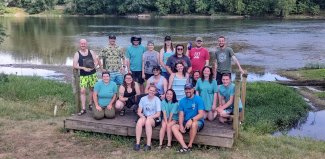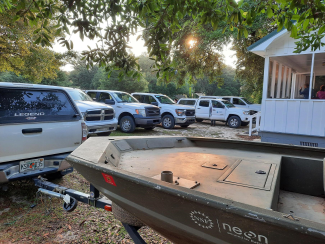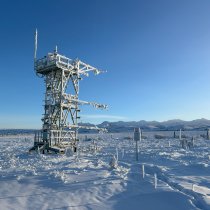Domain Digest No. 11: How NEON Beat the Summer Heat
October 14, 2024
Summer 2024 was the fourth-hottest on record for the U.S. and hottest on record for the Northern Hemisphere as a whole. Across the Observatory, many NEON field sites experienced extended bouts of extreme heat and some record-breaking temperatures. When temperatures rise, field staff safety is a priority.
The summer was notable for persistently high temperatures in many regions. A heat dome over the Southwest kept the thermometer over 110°F (43°C) in some areas for several weeks in July and August. Texas saw one of its hottest summers on record, with some areas seeing temperatures well over 100°F. In the Mid-Atlantic, daily temperatures reached the high 90s to 100°F, coupled with high humidity. In the Great Lakes region, above-average temperatures were recorded alongside high humidity, which elevated heat index levels. Northern Alaska also experienced higher-than-normal temperatures. Across NEON, many Domains and individual field sites experienced one of their top five warmest summers to date. These extreme conditions create safety risks and operational challenges for NEON field staff working outdoors. Exposure to prolonged heat and high humidity makes regular hydration and shade breaks essential.
To address these challenges, NEON field staff adjusted schedules and took precautionary measures to keep cool. Along the way, they also managed to have some summer fun! Chau Tran, the Field Science Lead for the NEON program, says, "We take the safety of field staff very seriously across NEON Domains, and that includes dealing with the day-to-day natural elements. It was a brutally hot summer. I appreciate the safety measures our field teams take to remain safe: monitoring environmental conditions as well as their coworker status throughout the day, shifting work to the earliest part of the day, increasing hydration and rest periods in the shade, and stopping work if unsafe."
Domain 02 – Mid-Atlantic

Domain 02 found a way to beat the heat with swimming and a cookout at the Shenandoah River in Virginia.

Mackenzie Dickson dumps a cooler of water on Carl Malinsky after a hot day of plant diversity at Smithsonian Conservation Biology Institute (SCBI) in Virginia.

Becca Arnold takes a break for lunch under a large field umbrella at the Lewis Run (LEWI) aquatic site in Virginia.

Ashley Landes and Benjamin Virnston trying to beat the heat with their field hats during plant diversity at SCBI.
Domain 03 – Atlantic Southeast

Victoria Frazier and Breeann Ortega-Roberts boating down the Flint River (FLNT) in Georgia. Ortega-Roberts says, “Things are so much cooler on the river. Especially when we ‘accidentally’ get water on ourselves during water sampling!”

Ortega-Roberts at tower top at Jones Ecological Research Center (JERC) in Georgia. Sunhats are a crucial piece of headgear, even with climbing PPE.

The Domain 03 trucks lined up in front of the staff house in Georgia, ready to roll out at sunrise so the teams can finish work before temperatures get too high.
Domain 15 – Great Basin

Maria Viggiano Beltrocco and Ingrid Ortiz Gonzales of Domain 04 (Puerto Rico) travelled to Red Butte Creek (REDB) in Utah (Domain 15) to provide training in aquatic science protocols for new D15 staff. Here, they are conducting a riparian assessment. Shade and water helped to keep everyone cool!
D04 – Atlantic Neotropical

Under the shade of a tent, technician Suhey Ortiz-Rosa calibrates the Double Fence Intercomparison Reference (DFIR) at Guánica Forest (GUAN) in Puerto Rico. The DFIR is used to measure precipitation.

Maria Beltrocco troubleshoots comms at Lajas Experimental Station (LAJA) in Puerto Rico.
Domain 17 – Pacific Southwest

Evan Donoso and Eissas Ouk, of Domain 20 (Hawaii), traveled to California to help with the Lower Teakettle (TEAK) sensor refresh. Ouk says, “It was a daily reminder to put on sunscreen!”


